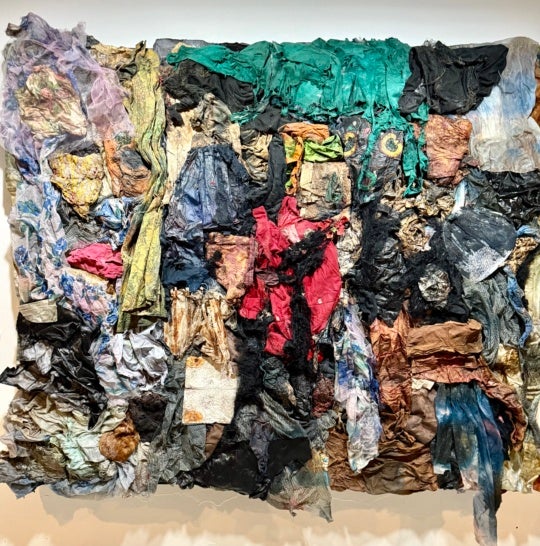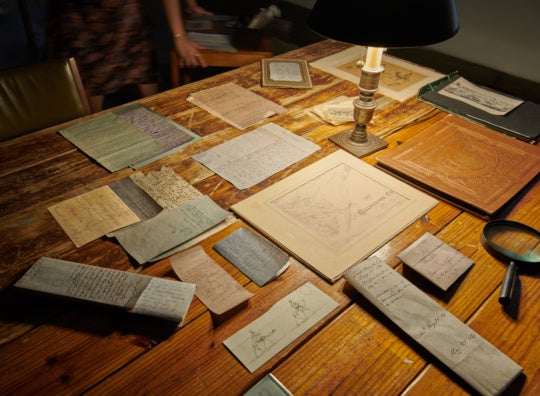
In a famous passage from the Blue Book, Ludwig Wittgenstein cautions: “We are most strongly tempted to think that here are things hidden, something we can see from the outside but which we can’t look into. And yet nothing of the sort is the case.” The title of Gyun Hur’s latest exhibition toys with metaphors of hiddenness, suggesting works that are private or hermetic. Yet the most fascinating thing about this work is precisely how it subverts these ideas.
The exhibition, on view through March 1 at Get This! Gallery, centers on a single large installation in which Hur’s familiar shredded flowers are mixed with soil and black glitter to create a primitive landscape containing mirror lakes, fragments of pottery, and a few isolated patches of color. On the L-shaped glass tabletop that stands barely knee high, mounds of petals rise like colored volcanoes. Hur has spoken of this new work in terms of a “rupture,” which captures how sharply it departs from many of the pieces for which she is best known. Gone are the brightly colored bands and fields. Instead, darkness prevails, penetrated and orbited by flickers of light.

The work divides into three planes: the earth, the glass platform suspended just above it, and the lights far above. This arrangement itself leaves everything open to view. The floating petal mounds are objects with nothing and nowhere to hide, since the mirrors and glass make it possible to see both their tops and undersides simultaneously. Looked at from the right angle, everything in the work is transparent and visible. The trick is finding the right viewing spot. The work demands to be inhabited, not merely scrutinized from a polite distance. Its texture only appears up close. Sit down on the gallery floor, inside the crook of the L; from that vantage point, you can see the mirrors multiply the landscape outward, and the soft lumps and pools of color resolve into granular accumulations of individual petals.
Inwardness can connote a state of solitude or emotional isolation, but Hur’s practice over the past several years has been increasingly participatory and communal. This installation is a collaboration featuring lighting by designer Rebecca Makus and a rotating set of wall texts by three writers. Since every aspect of the lighting can be adjusted by the viewers, the work changes to correspond with their intentions as well. Experimenting with different combinations of the lights produces effects ranging from meditative to clinical.
Like the physical setting, the conceptual setting of the work is also changeable. The accompanying texts set up wildly different interpretive frameworks. Kristen Juarez’s mystical rumination on dark matter centers on a scientific metaphor that imbues esoteric physics with emotion. This is a much different tone than the one established by Lilly Lampe’s torrent of impassioned poetry, or Ruiyan Xu’s powerful and unnerving organic analogy of flesh and fire.

Wallace Stevens once proposed the merging of a person with their place: “The soul, he said, is composed/ Of the external world.” This work exposes the soul not by looking inward, but by spreading outward. The tuning of the light and the metaphorical possibilities suggested by the text interact with the installation’s material structure to produce a system of possible meanings, rather than a single determinate interpretation. In Wittgensteinian terms, what the work means depends on the context of its use. With its inherently mutable features, Hur’s system of collaboration gives us many works in one.
The risk in such a project is that it allows in too many possible meanings while refusing to commit strongly to any one of them. This would make it not an expression of instability as a condition of life, but rather an unstable or directionless work. If this feels more like the latter, it is probably because this is a transitional project. Hur’s past works demonstrate her capacity for precise expressive control. Too many meanings operating at once become a blur. It will be interesting to see what happens when the ideas being handled provisionally here come into sharper focus.
Dan Weiskopf is an associate professor of philosophy and an associate faculty member in the Neuroscience Institute at Georgia State University. He is the author, with Fred Adams, of An Introduction to the Philosophy of Psychology, forthcoming from Cambridge University Press.




